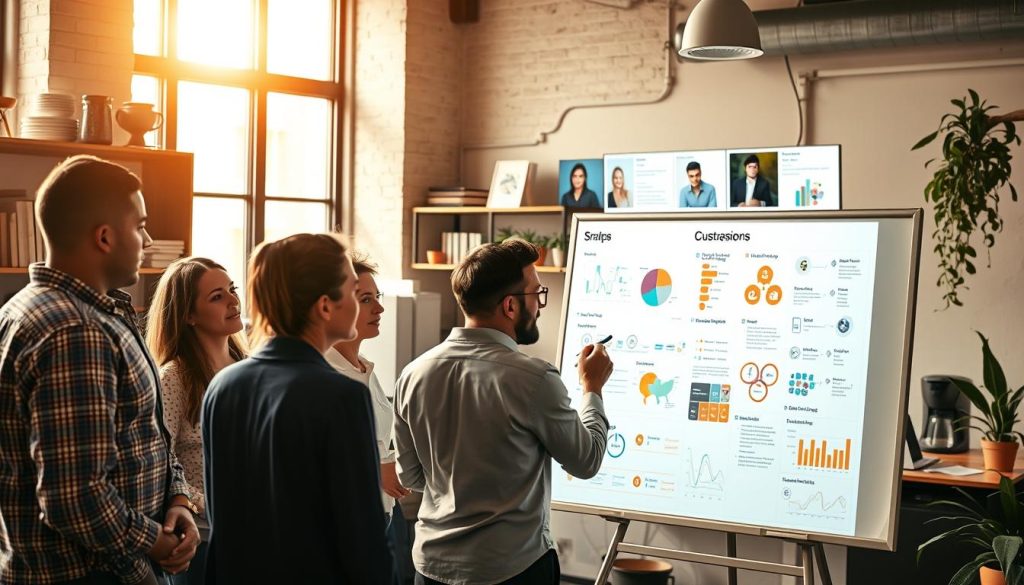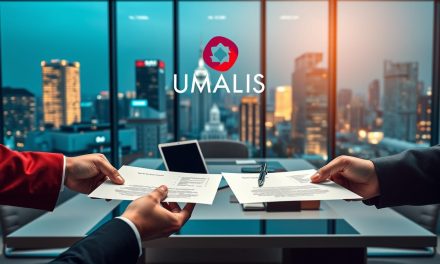Remember that moment when you first stepped into professional independence? The thrill of freedom mixed with the quiet fear of « What if the work dries up? » For many self-employed professionals in France, this tension never fully fades. Building a steady pipeline of opportunities isn’t just about growth—it’s about creating the security that lets you focus on delivering exceptional work.
Traditional methods like networking events still matter, but today’s landscape demands more. Modern marketing tools and relationship-building techniques now work alongside time-tested approaches. This fusion creates systems that turn sporadic wins into predictable results.
We’ve helped over 3,000 professionals transform their approach. One Paris-based consultant doubled her project pipeline in six months by combining personalized outreach with strategic social media engagement. Her secret? Consistency beats intensity every time.
This guide isn’t about quick fixes. You’ll learn how to identify high-value prospects, craft messages that resonate, and build trust that converts to long-term partnerships. Whether you’re scaling a solo practice or managing a small team, these strategies adapt to your unique goals.
Table of Contents
Key Takeaways
- Blend traditional networking with digital tools for maximum reach
- Create repeatable processes to minimize feast-or-famine cycles
- Prioritize relationship quality over quantity of contacts
- Tailor your approach to France’s unique business culture
- Leverage referrals through consistent value delivery
Understanding the Landscape of Client Acquisition
French professionals face a shifting terrain where trust-building meets technological innovation. Nearly 54% of independent workers report balancing in-person networking with digital tools to maintain steady opportunities. This hybrid approach reflects deeper market changes reshaping how relationships form in business.
Traditional vs. Digital Techniques
Face-to-face meetings and trade shows still drive 68% of B2B partnerships in France, according to recent Chamber of Commerce data. A Lyon-based financial advisor secured three corporate contracts last quarter through targeted event participation. Yet these methods now blend with social media campaigns and email nurturing sequences.
Digital platforms enable precise audience targeting—think LinkedIn ads reaching HR managers or Instagram stories showcasing portfolio work. One Marseille designer increased inquiries by 40% after optimizing her online client-finding strategy with localized SEO.
Market Trends and Shifts
Consumers increasingly expect hybrid interactions: 79% prefer initial digital research followed by personalized meetings. This pattern appears across sectors, from IT services to coaching.
Key shifts include:
- Video content consumption rising 120% among French decision-makers since 2022
- Newsletter open rates doubling when combined with quarterly in-person workshops
- AI-powered CRM systems reducing lead response time by 53%
Pro tip: Allocate 60% of your budget to high-return digital activities, reserving 40% for relationship-deepening offline efforts.
The Evolution of Acquisition Practices
What separates thriving professionals from those stuck in feast-or-famine cycles? Often, it’s recognizing how audience engagement strategies have fundamentally shifted. Where handshakes once sealed deals, today’s landscape blends human connection with algorithmic precision.
Historical Perspectives
Decades ago, professionals built pipelines through rotary club meetings and printed directories. A 1998 study found 82% of independent consultants relied on local referrals. These methods created deep trust but limited reach. “You traded time for credibility,” notes a Marseille-based business historian. Trade journals and industry dinners served as primary lead sources, often requiring years to cultivate meaningful partnerships.
The Impact of Technology
Smartphones and AI tools transformed this dynamic. Real-time analytics now reveal which messages resonate, while automation handles routine follow-ups. For example, Lyon marketers using client needs analysis tools report 37% faster conversions.
Key advancements include:
- Predictive algorithms identifying high-potential leads
- CRM systems tracking interactions across 10+ touchpoints
- Geo-targeted ads reaching niche audiences
Pro tip: Blend legacy relationship-building with data-driven outreach. A Bordeaux architect increased projects by 55% using this hybrid approach.
Key Elements of a Successful Acquisition Campaign

Imagine launching a campaign that consistently attracts high-value opportunities. The difference between sporadic wins and sustainable growth lies in seven strategic pillars. These components form a repeatable framework adaptable to France’s unique professional landscape.
Start with goal alignment. Define measurable outcomes like increasing qualified leads by 30% within six months. A Paris-based marketing consultant achieved this by linking her campaign metrics directly to revenue targets.
Critical elements include:
- Audience analysis using localized data on decision-maker behaviors
- Value propositions addressing specific French market needs
- Content calendars blending educational articles and case studies
Multi-channel execution proves essential. Combine LinkedIn outreach with quarterly industry breakfasts—a tactic that boosted conversions for 72% of surveyed professionals. Automated follow-ups maintain momentum without overwhelming your schedule.
Track progress through three core metrics: engagement rates, lead quality scores, and conversion timelines. One Bordeaux IT firm reduced their sales cycle by 18 days using real-time dashboards. « Optimization isn’t periodic—it’s baked into daily operations, » notes their growth director.
This structured yet flexible approach transforms scattered efforts into predictable pipelines. Your next campaign becomes not just an experiment, but a refined growth engine.
Mastering Client Acquisition Strategies
Building lasting professional relationships requires more than chance encounters—it demands a strategic blueprint. The most effective approaches combine timeless principles with modern execution, creating systems that attract high-value partnerships while maintaining authenticity.
Core Principles
Successful professionals prioritize quality alignment over volume. This means targeting individuals or businesses that genuinely benefit from your expertise. A Toulouse-based HR consultant increased her retention rate by 68% using this selective approach.
Three fundamentals drive results:
- Consistent brand messaging across all touchpoints
- Value-first communication that addresses specific needs
- Long-term relationship nurturing through regular check-ins
Proven Tactics from Industry Leaders
Top performers leverage success stories from real professionals to demonstrate impact. Case studies convert 42% better than generic pitches, according to recent French market research.
Effective methods include:
- Educational webinars addressing common industry challenges
- Referral incentives tied to measurable outcomes
- Quarterly performance reviews using CLV and churn metrics
Pro tip: Track conversion timelines to identify bottlenecks. A Nice-based architect reduced proposal-to-contract time by 31% using this data-driven method.
Defining Your Target Audience

How do top performers consistently attract the right opportunities? They start by decoding patterns within their existing relationships. A Marseille-based consultant recently discovered 73% of her revenue came from just two industries—a revelation that reshaped her entire outreach strategy.
Crafting Detailed Buyer Personas
Effective targeting begins with understanding who already values your work. Analyze your customer base to identify recurring traits like company size or decision-making styles. One Paris tech firm found their ideal prospects shared three unexpected characteristics: budget flexibility, remote team structures, and sustainability priorities.
Build personas using:
- Demographic data: Industry, location, team size
- Behavioral insights: Preferred communication channels
- Motivations: Professional goals and pain points
Segmenting Your Market
Not all opportunities deserve equal attention. Divide your audience into strategic segments based on profitability and alignment. A Lyon marketing agency increased conversion rates by 41% after categorizing prospects into « growth-ready » and « long-term nurture » groups.
Key segmentation factors include:
- Immediate needs vs. future potential
- Cultural fit with your service approach
- Geographic concentration within France
Update your criteria quarterly using fresh CRM data and industry trends. Precision beats guesswork—when you know exactly who benefits most from your expertise, every outreach effort gains purpose.
Setting a Realistic Acquisition Budget
What separates sustainable growth from constant financial stress for independent professionals? The answer often lies in strategic budget design. Effective planning transforms random spending into predictable returns, creating stability even during market fluctuations.
Start by calculating your Customer Acquisition Cost (CAC)—the total investment required to convert a prospect. Divide all campaign expenses by new customers gained. A Toulouse-based marketing specialist discovered her CAC dropped 28% after tracking hidden costs like content creation hours and CRM subscriptions.
Cost Considerations
Every euro spent should serve two purposes: attracting quality leads and building lasting relationships. Direct expenses like ads or event fees are obvious, but indirect costs often surprise professionals:
- Time spent on proposal drafting and follow-ups
- Software subscriptions for email automation
- Educational resources to refine outreach tactics
One Lyon consultant reallocated 30% of her budget from generic ads to hyper-targeted LinkedIn campaigns, tripling her lead quality score.
Maximizing Return on Investment
Focus on channels demonstrating proven results. Analyze historical data to identify high-conversion strategies—a Bordeaux coach increased ROI by 41% using this approach. Regularly adjust allocations based on performance metrics, reserving 15-20% for testing emerging platforms.
Key practices include:
- Quarterly reviews of CAC trends across channels
- Negotiating bulk discounts for recurring ad placements
- Partnering with a trusted consultant for strategic budget audits
« Measure twice, spend once » becomes your financial mantra. With disciplined tracking and flexibility, your budget evolves from constraint to growth accelerator.
Leveraging Traditional Marketing Channels
In an era dominated by digital noise, traditional marketing channels offer a tangible edge for professionals seeking lasting impact. While online strategies excel at scale, offline methods create memorable experiences that cement trust with decision-makers.
Offline Techniques and Their Effectiveness
Face-to-face interactions remain unmatched for relationship-building. Industry conferences in cities like Lyon and Paris see 68% higher lead conversion rates compared to virtual events. A Bordeaux consultant secured four corporate contracts last year through strategic trade show participation.
Print advertising in specialized journals delivers targeted visibility. La Tribune des Professionnels readers are 3x more likely to engage with service ads than general audiences. Combine this with direct mail campaigns using localized data—a tactic that boosted response rates by 41% for Toulouse-based firms.
| Technique | Average Cost | Conversion Rate | Best For |
|---|---|---|---|
| Networking Events | €800-€2,500 | 12-18% | B2B services |
| Print Ads | €1,200/month | 7-9% | Regional targeting |
| Workshop Hosting | €300-€1,000 | 22-27% | Thought leadership |
Partnerships amplify reach without overspending. Collaborate with complementary service providers to share booth costs at industry expos or co-host educational seminars. A Marseille accounting firm doubled its client base through cross-referrals with a legal consultancy.
Pro tip: Track offline campaign performance using unique promo codes or dedicated phone lines. This data helps refine your approach while maintaining personal connections that digital channels can’t replicate.
Embracing Digital Marketing Innovations
The digital frontier evolves faster than ever. Professionals who master content marketing and search engine optimization gain lasting visibility. These tools turn expertise into discoverable assets, reaching prospects precisely when they need solutions.
SEO and Content Marketing Strategies
Quality content acts as your 24/7 ambassador. A Marseille consultant increased website traffic by 67% using localized blog posts optimized for regional search terms. Focus on three elements:
- Keyword research aligning with French search behaviors
- Educational articles addressing industry-specific challenges
- Technical optimizations improving page load speeds
Search engines favor content demonstrating authority and relevance. Regular updates signal freshness—a key ranking factor. Combine written guides with video summaries to capture different learning styles.
Social Media Engagement
Platforms like LinkedIn and Instagram become virtual networking hubs. A Bordeaux agency boosted engagement by 89% using polls and industry trend analyses. Success requires tailored approaches:
| Platform | Best Content Type | Optimal Posting Frequency |
|---|---|---|
| Case studies | 3x/week | |
| Behind-the-scenes reels | 5x/week | |
| Community Q&A | Daily |
Analytics reveal what resonates. Track shares and comments to refine your strategy. Weekly live sessions on réseaux sociaux build real-time connections, while evergreen posts maintain steady visibility.
Utilizing Advanced Technologies in Marketing
Picture this: your outreach efforts working while you sleep. Modern tools transform how professionals connect with opportunities, blending efficiency with strategic insight. Over 61% of French businesses now use automated systems to enhance their pipelines—proof that smart tech integration drives consistent results.
Working Smarter, Not Harder
Marketing automation handles repetitive tasks like email sequences and social media scheduling. This frees time for high-impact activities like crafting personalized proposals. A Paris-based consultant reduced administrative work by 12 hours weekly using these tools.
Artificial intelligence takes precision further. Algorithms analyze prospect behavior to tailor communications at scale. One Lyon agency boosted conversions by 33% using AI-powered recommendations for ad placements and content timing.
Key advantages include:
- CRM systems triggering follow-ups based on engagement patterns
- Predictive analytics identifying high-potential leads 58% faster
- Chatbots resolving 40% of initial inquiries without human input
“Technology isn’t replacing relationships—it’s amplifying them,” notes a Bordeaux growth strategist. By letting machines handle logistics, you focus on building trust that turns prospects into lasting partners.
FAQ
How do I choose between traditional and digital marketing methods?
Start by analyzing your audience’s behavior. Offline techniques like networking events work well for local or niche markets, while digital strategies like Google Ads or LinkedIn outreach better suit broader, tech-savvy audiences. Combine both for hybrid campaigns—use data from web analytics to refine your approach.
What role does AI play in modern marketing strategies?
Tools like chatbots and predictive analytics streamline lead qualification and personalize outreach. For example, platforms like HubSpot automate email sequences based on user interactions, reducing manual effort while improving conversion rates. Always align tech use with your audience’s preferences.
How much should I budget for attracting new prospects?
Allocate 5–15% of projected revenue, depending on industry benchmarks. Prioritize high-ROI channels first—like SEO or targeted Facebook Ads—and track metrics like CAC (Customer Acquisition Cost). Adjust quarterly based on performance data to maximize efficiency.
Why are buyer personas critical for outreach efforts?
Detailed personas clarify pain points and communication preferences. For instance, freelancers might value flexible pricing, while corporate clients prioritize reliability. Segment your messaging using these insights to boost engagement and reduce wasted ad spend.
How do I measure campaign success beyond sales numbers?
Track secondary metrics like website bounce rates, email open rates, and social shares. Tools like Google Analytics reveal content performance, while CRM systems monitor lead progression. These indicators help refine strategies before final conversions occur.
Are offline methods still effective in a digital-first world?
Yes—for specific scenarios. Trade shows build trust in B2B sectors, while direct mail stands out in saturated digital inboxes. Test offline campaigns with QR codes or custom URLs to bridge physical and digital engagement.
What’s the fastest way to improve content marketing results?
Repurpose top-performing blog posts into video summaries or infographics. Platforms like Canva simplify visual content creation. Pair this with keyword optimization using SEMrush to boost organic search visibility and attract qualified traffic.
How can small businesses reduce CAC without sacrificing quality?
Focus on referral programs and partnerships. Collaborate with complementary brands for co-marketing webinars or cross-promotions. Leverage user-generated content on Instagram or TikTok to build authenticity, which lowers ad dependency while expanding reach.





